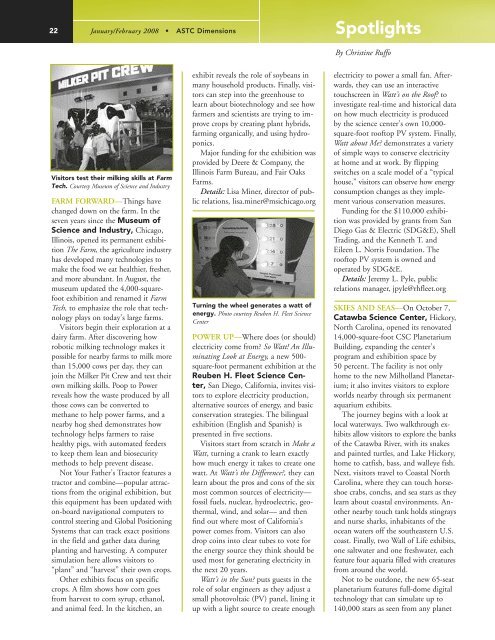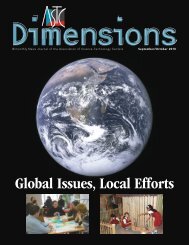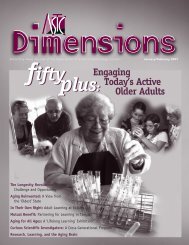Scientists Speak about Nano - Association of Science - Technology ...
Scientists Speak about Nano - Association of Science - Technology ...
Scientists Speak about Nano - Association of Science - Technology ...
Create successful ePaper yourself
Turn your PDF publications into a flip-book with our unique Google optimized e-Paper software.
22 January/February 2008 • ASTC Dimensions<br />
Visitors test their milking skills at Farm<br />
Tech. Courtesy Museum <strong>of</strong> <strong>Science</strong> and Industry<br />
FARM FORWARD—Things have<br />
changed down on the farm. In the<br />
seven years since the Museum <strong>of</strong><br />
<strong>Science</strong> and Industry, Chicago,<br />
Illinois, opened its permanent exhibition<br />
The Farm, the agriculture industry<br />
has developed many technologies to<br />
make the food we eat healthier, fresher,<br />
and more abundant. In August, the<br />
museum updated the 4,000-squarefoot<br />
exhibition and renamed it Farm<br />
Tech, to emphasize the role that technology<br />
plays on today’s large farms.<br />
Visitors begin their exploration at a<br />
dairy farm. After discovering how<br />
robotic milking technology makes it<br />
possible for nearby farms to milk more<br />
than 15,000 cows per day, they can<br />
join the Milker Pit Crew and test their<br />
own milking skills. Poop to Power<br />
reveals how the waste produced by all<br />
those cows can be converted to<br />
methane to help power farms, and a<br />
nearby hog shed demonstrates how<br />
technology helps farmers to raise<br />
healthy pigs, with automated feeders<br />
to keep them lean and biosecurity<br />
methods to help prevent disease.<br />
Not Your Father’s Tractor features a<br />
tractor and combine—popular attractions<br />
from the original exhibition, but<br />
this equipment has been updated with<br />
on-board navigational computers to<br />
control steering and Global Positioning<br />
Systems that can track exact positions<br />
in the field and gather data during<br />
planting and harvesting. A computer<br />
simulation here allows visitors to<br />
“plant” and “harvest” their own crops.<br />
Other exhibits focus on specific<br />
crops. A film shows how corn goes<br />
from harvest to corn syrup, ethanol,<br />
and animal feed. In the kitchen, an<br />
exhibit reveals the role <strong>of</strong> soybeans in<br />
many household products. Finally, visitors<br />
can step into the greenhouse to<br />
learn <strong>about</strong> biotechnology and see how<br />
farmers and scientists are trying to improve<br />
crops by creating plant hybrids,<br />
farming organically, and using hydroponics.<br />
Major funding for the exhibition was<br />
provided by Deere & Company, the<br />
Illinois Farm Bureau, and Fair Oaks<br />
Farms.<br />
Details: Lisa Miner, director <strong>of</strong> public<br />
relations, lisa.miner@msichicago.org<br />
Turning the wheel generates a watt <strong>of</strong><br />
energy. Photo courtesy Reuben H. Fleet <strong>Science</strong><br />
Center<br />
POWER UP—Where does (or should)<br />
electricity come from? So Watt! An Illuminating<br />
Look at Energy, a new 500square-foot<br />
permanent exhibition at the<br />
Reuben H. Fleet <strong>Science</strong> Center,<br />
San Diego, California, invites visitors<br />
to explore electricity production,<br />
alternative sources <strong>of</strong> energy, and basic<br />
conservation strategies. The bilingual<br />
exhibition (English and Spanish) is<br />
presented in five sections.<br />
Visitors start from scratch in Make a<br />
Watt, turning a crank to learn exactly<br />
how much energy it takes to create one<br />
watt. At Watt’s the Difference?, they can<br />
learn <strong>about</strong> the pros and cons <strong>of</strong> the six<br />
most common sources <strong>of</strong> electricity—<br />
fossil fuels, nuclear, hydroelectric, geothermal,<br />
wind, and solar— and then<br />
find out where most <strong>of</strong> California’s<br />
power comes from. Visitors can also<br />
drop coins into clear tubes to vote for<br />
the energy source they think should be<br />
used most for generating electricity in<br />
the next 20 years.<br />
Watt’s in the Sun? puts guests in the<br />
role <strong>of</strong> solar engineers as they adjust a<br />
small photovoltaic (PV) panel, lining it<br />
up with a light source to create enough<br />
Spotlights<br />
By Christine Ruffo<br />
electricity to power a small fan. Afterwards,<br />
they can use an interactive<br />
touchscreen in Watt’s on the Ro<strong>of</strong>? to<br />
investigate real-time and historical data<br />
on how much electricity is produced<br />
by the science center’s own 10,000square-foot<br />
ro<strong>of</strong>top PV system. Finally,<br />
Watt <strong>about</strong> Me? demonstrates a variety<br />
<strong>of</strong> simple ways to conserve electricity<br />
at home and at work. By flipping<br />
switches on a scale model <strong>of</strong> a “typical<br />
house,” visitors can observe how energy<br />
consumption changes as they implement<br />
various conservation measures.<br />
Funding for the $110,000 exhibition<br />
was provided by grants from San<br />
Diego Gas & Electric (SDG&E), Shell<br />
Trading, and the Kenneth T. and<br />
Eileen L. Norris Foundation. The<br />
ro<strong>of</strong>top PV system is owned and<br />
operated by SDG&E.<br />
Details: Jeremy L. Pyle, public<br />
relations manager, jpyle@rhfleet.org<br />
SKIES AND SEAS—On October 7,<br />
Catawba <strong>Science</strong> Center, Hickory,<br />
North Carolina, opened its renovated<br />
14,000-square-foot CSC Planetarium<br />
Building, expanding the center’s<br />
program and exhibition space by<br />
50 percent. The facility is not only<br />
home to the new Milholland Planetarium;<br />
it also invites visitors to explore<br />
worlds nearby through six permanent<br />
aquarium exhibits.<br />
The journey begins with a look at<br />
local waterways. Two walkthrough exhibits<br />
allow visitors to explore the banks<br />
<strong>of</strong> the Catawba River, with its snakes<br />
and painted turtles, and Lake Hickory,<br />
home to catfish, bass, and walleye fish.<br />
Next, visitors travel to Coastal North<br />
Carolina, where they can touch horseshoe<br />
crabs, conchs, and sea stars as they<br />
learn <strong>about</strong> coastal environments. Another<br />
nearby touch tank holds stingrays<br />
and nurse sharks, inhabitants <strong>of</strong> the<br />
ocean waters <strong>of</strong>f the southeastern U.S.<br />
coast. Finally, two Wall <strong>of</strong> Life exhibits,<br />
one saltwater and one freshwater, each<br />
feature four aquaria filled with creatures<br />
from around the world.<br />
Not to be outdone, the new 65-seat<br />
planetarium features full-dome digital<br />
technology that can simulate up to<br />
140,000 stars as seen from any planet





